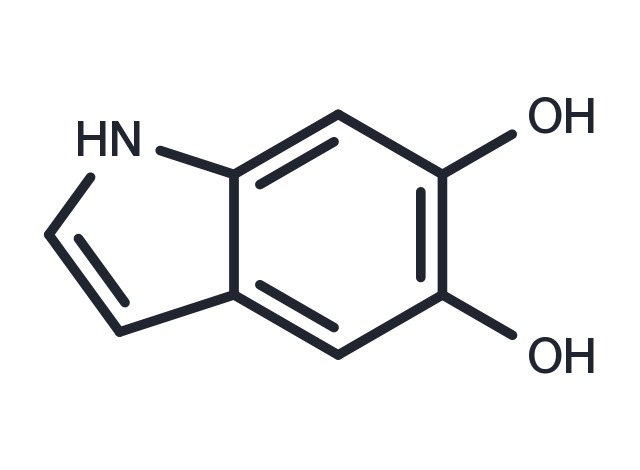store at low temperature
Powder: -20°C for 3 years | In solvent: -80°C for 1 year

5,6-Dihydroxyindole (Dopamine lutine) is a melanin precursor and has a broad-spectrum antibacterial, antiviral, antifungal, antiparasitic activity. It has cytotoxic effects and is strongly toxic against various pathogens.

| Pack Size | Availability | Price/USD | Quantity |
|---|---|---|---|
| 100 mg | In stock | $ 29.00 |

| Description | 5,6-Dihydroxyindole (Dopamine lutine) is a melanin precursor and has a broad-spectrum antibacterial, antiviral, antifungal, antiparasitic activity. It has cytotoxic effects and is strongly toxic against various pathogens. |
| In vitro | 5,6-Dihydroxyindole (1, 10, 20, 50, 100 μM; for 4 hours) demonstrably reduces OD492 values in a dose-dependent manner. When Sf9 cells are pre-treated with 1.0 mM 5,6-Dihydroxyindole for 4 hours, there is a significant mortality rate of 97%, with LC50 values reported at 20.3 μM in buffer and 131.8 μM in culture medium, respectively. Additionally, pre-incubating a baculovirus stock with 1.25 mM 5,6-Dihydroxyindole for 3 hours almost completely inhibits the production of recombinant proteins. The compound also shows biological activity against lambda bacteriophage and wasp eggs (Microplitis demolitor), with LC50 values of 5.6 μM and 111.0 μM, respectively. Furthermore, both 5,6-Dihydroxyindole and its spontaneous oxidation products exhibit efficacy against viruses and parasitic wasps [1]. |
| Synonyms | Dopamine lutine |
| Molecular Weight | 149.15 |
| Formula | C8H7NO2 |
| CAS No. | 3131-52-0 |
store at low temperature
Powder: -20°C for 3 years | In solvent: -80°C for 1 year
H2O: Insoluble
DMSO: 45.0 mg/mL (301.7 mM), Sonication is recommended.
You can also refer to dose conversion for different animals. More
bottom
Please see Inhibitor Handling Instructions for more frequently ask questions. Topics include: how to prepare stock solutions, how to store products, and cautions on cell-based assays & animal experiments, etc.
5,6-Dihydroxyindole 3131-52-0 Metabolism Endogenous Metabolite Dopamine lutine inhibitor inhibit
